I was planning for a trip to Tirthan Valley for quite some time but my obsession with Uttarakhand prevented me to actively pursue the trip. It was this blog which hastened the process of firming this trip. The process started with booking Raju’s Guest House at Gushaini which has a reputation of getting booked for months in advance. After having booked the Raju’s Guest House in the first week of December 2010 for 3 days’ stay in mid-April 2011, I decided about the places to be visited. A visit to Jalori Pass was added to the itinerary and we were to return to Kalka for home journey via Chindi. Later, when my son’s family desired to join us for the trip, Shimla was added to balance the aspirations of the younger ones in our trip. So we were now 4 adults and two children (aged 7 and 3 years) all set for the trip.
Mumbai-Chandigarh (Flight), Chandigarh-Mandi (210 kms)
We took GoAir’s 9.30 a.m. direct flight to Chandigarh which was delayed by 30 minutes at Mumbai to accommodate the passengers of the connecting flights coming from Goa and Bangalore. The flight landed at Chandigarh airport at 11.30 a.m. After picking our baggage, we were out of the airport at 12 noon. The driver with his Innova arranged by my Delhi friend for Mandi drop was already waiting for us (Rs.3500/- all inclusive). We commenced our road journey to Mandi at around 12.30 pm in a pleasant weather condition, the temperature being 29C. Since traffic jam on NH 21 (Kiratpur – Bilaspur stretch) was a regular feature due to road widening work in progress, he indicated that he would take Chandigarh-Kalka-Dharampur-Sallaghat-Brahmpukar route and join NH-21 at Ghaghas for Mandi. I readily agreed to his suggestion. At Dharampur, we had lunch at Modern Dabha (good food). From Dharampur to Sallaghat, the road was more like single lane but wide enough to cross two small vehicles. The road was jerky at many places restricting the speed to around 30-40 kmph. The plus points of this route were - not much traffic on the road and the scenic route. From Sallghat to Brahmpukhar, the road was slightly better than the earlier segment and wider at some places. Brahmpukhar-Ghaghas route was the most scenic journey reminding me of my road journey from Binsar forest gate to the road head for zero point, 4 years back. From Ghaghas to Mandi, the road was in excellent condition. We reached Mandi at 8.30 p.m. after taking few breaks on the way.
I had not booked any hotel at Mandi but Rajiv Bharati (of Raju’s Guest House, Gushaini) had suggested me to stay at Rajmahal Palace Hotel as in his view, the hotel had a good ambience being a heritage property. His second choice was Visco Resorts located on the highway 1 km before Mandi. I took a chance for the former and got two double bedded rooms @ Rs.990/- (including taxes) per room. The rooms were clean having 24 hours hot water and the TV. The hotel was earlier a guest house for Mandi’s royal family which was converted in to a hotel in 1986. I was surprised to note that the hotel had only 12 rooms but tariff ranged from Rs.990/- to as high as Rs.3960/-. We had dinner at the hotel’s restaurant and the food was excellent.
The sporadic showers in the evening accompanied by strong breeze had brought the temperature down considerably requiring the use of blankets in the night.
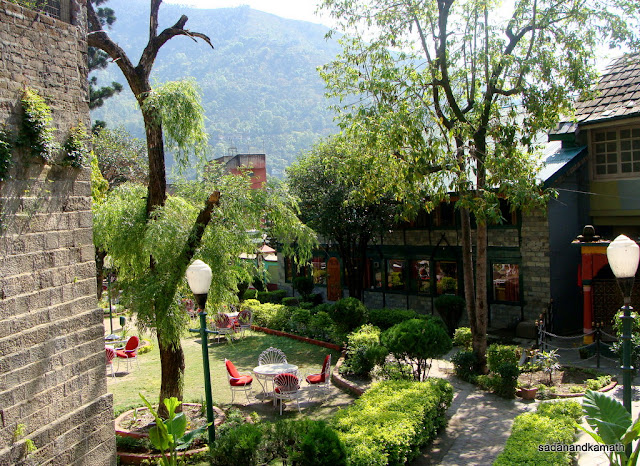 |
| Rajmahal Palace Hotel, Mandi. |
 |
| One of many oil paintings adorning Hotel lobby. |
Mandi-Gushaini (80 kms)
We had not planned for any sight-seeing around Mandi as we were eager to spend more time in the Tirthan Valley. Raju had earlier suggested me not to book vehicle for a round trip as he was somewhat apprehensive of the attitude of some of the drivers from plains who had created problems for some of his clients in the past. He had suggested that he would send a vehicle from Banjar to pick up us from Mandi for Gushaini drop at around 10.30 am which I had agreed. After breakfast at the hotel’s restaurant, I strolled around the hotel and found that there were collection of old paintings adorning the lobby walls of restaurant as well as of deluxe rooms and suits. Knowing my interest, Man Singh Thakur, the General Manager of the hotel, took us to residential palace of the royal family adjoining the hotel where there were many wood and stone carved antiques on display in the veranda of the Palace and some rare stone sculptures lying in the open court yard of the Palace.
There were more things to see inside the Palace but we were short of time as the vehicle for Gushaini drop had already reached the hotel’s parking lot. Mansingh suggested to plan for 2-3 days’ stay in Mandi in my next visit when he would plan visits to some off-beat places around Mandi. I agreed with him. It was a pleasant surprise to find that the owner of Raju’s Guest House, Rajiv Bharti had himself come in his Bolero to pick us from Mandi as he could not get a SUV in Banjar for us. He charged Rs.1500/- for Gushaini drop.
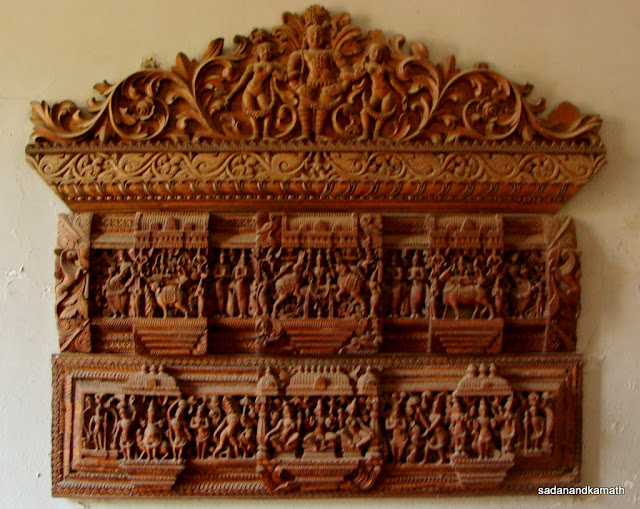 |
| Wood carved panel in the Palace, Mandi. |
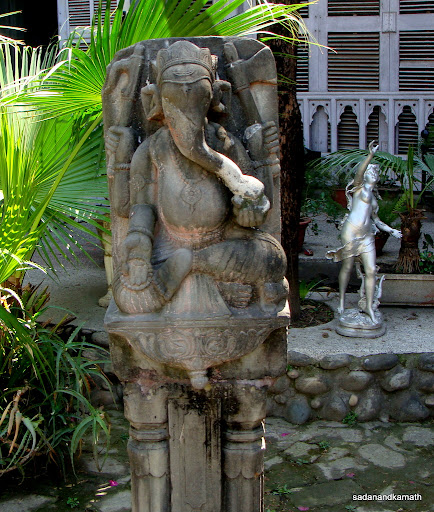 |
| one of many stone sculptures lying in the compound of the Palace, Mandi |
We started from Mandi at 11.00 a.m. and after spending sometime at Trilokinath temple complex (must visit place for those interested in temple architectures) which was about 1 km from our hotel, we proceeded towards Gushaini. The road was good up to Aut after which there were few stretches of bad road probably on account of truck traffic connected with some on-going hydro-electric projects. Between Larji and Banjar, the road bridge over Tirthan river was dismantled two months ago as it was badly damaged by an over-loaded truck. A mud road diversion of about 300m is now passing through Tirthan river with its water flowing through cemented pipes below the mud road surface. The new bridge which is under construction is expected to be ready before the onset of monsoon.
 |
| Stone carved wall of the Trilokinath Temple, Mandi |
 |
| Panch Vaktra (Shiva) temple at the confluence of rivers Beas and Suket, Mandi. |
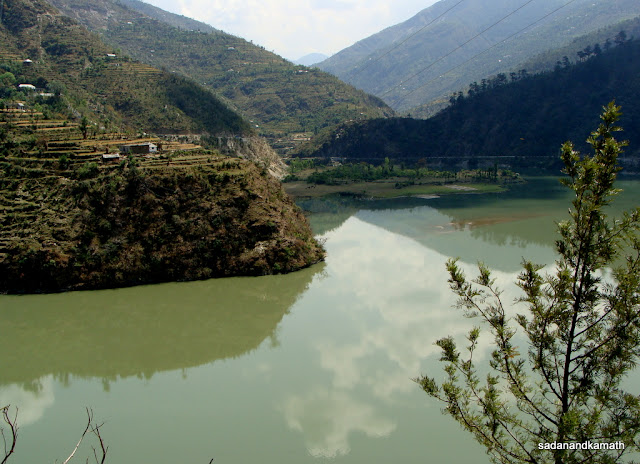 |
| Beas water at standstill near a dam in Larji. |
We reached Raju’s Guest House at around 1.30 pm. The crossing by the cable trolley over Tirthan river torrent to reach Raju's Guest House itself was a thrilling experience. The other option was to drive further one km towards Gushaini village, cross the pedestrian bridge over Tirthan river followed by one km of walk through orchards to reach the Guest House. We were ‘welcomed’ by Raju’s 5 pet dogs who soon become our friends wading their tails. We were in the good company of a group of 8 ladies from Mumbai who had checked in two days earlier.
 |
| Crossing Tirthan river on a cable trolley to reach Raju's Guest House ( in the background). |
 |
| Raju's Guest House with Raju in foreground. |
 |
| Tirthan River seen from Raju's Guest House. |
After a sumptuous lunch and some rest, we decided to trek 3 kms to Bandal village to see Sherawali Durga temple. Varun, son of Raju felt that it might be difficult with kids to trek Bandal village especially when there was a possibility of rains in the evening. So my wife and daughter-in-law decided to stay back with kids and myself and my son proceeded for 3 kms of trek at around 4.30 p.m. As we were about to start the trek, Yeti and Bulbul, two of 5 pet dogs of Raju proceeded ahead of us to lead us to the destination. The first one km of trek was all along Tirthan river albeit, at somewhat higher elevation, through orchards, up to the primary school where the pedestrian bridge over Tirthan river ended from the road side. Thereafter, it was climb all the way to Bandal village criss-crossing the mud road which goes to Bandal village. Share jeeps are available on this mud road but they are said to be irregular. We reached the lower Bandal village having a newly constructed Durga temple which had an intricately carved wooden door. The main temple of Sherawali Gara Durga was further 100m up reached by climbing a steep cemented staircase.
 |
| Yeti and Bulbul leading the way to Bandal village trek. |
 |
| A Bandal village girl. |
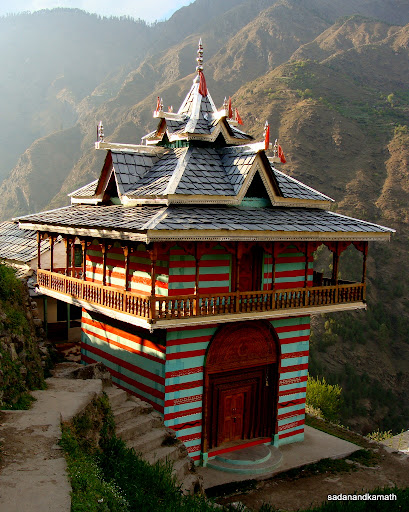 |
| Newly constructed temple at lower Bandal village. |
Sherawali Gara Durga temple is an old one and is under renovation in usual Himachali style. There is no deity of Durga Maa but a carved Durga Maa image painted in various colours is worshipped. The temple is highly revered by the villagers of Tirthan Valley. After darshan of Durga, we took a round of the temple. We had a clear view of two snow clad Himalayan peaks from the temple premises. As we were strolling in the village courtyard, children from the nearby houses came running towards us for a photo session which we gladly obliged. Since the weather was turning bad, we decided to return immediately without exploring the other parts of Bandal village. After reaching the primary school, we took the upper trek path for reaching the Guest House primarily to get a bird’s eye view of orchards. It seems our ‘guides’ Yeti and Bulbul did not like our idea and they continued to walk on the traditional route on the banks of Tirthan river, keeping an eye on us until we reached the Guest House. Soon it rained moderately for some time bringing down the night temperature considerably. However, room heaters made the night comfortable.
 |
| Sherawali Gara Durga Temple at Upper Bandal village. |
 |
| View from the temple, Bandal village. |
 |
| Bandak village children. |
An interesting observation of the attitude of our ‘guides’ was that Yeti will always be ahead of us showing the way and will not retraced even if we are not visible to him. He would simply wait for us rather than looking or us. Bulbul, on the other hand, will come back searching for us and lead to way. While returning, we took a wrong turn and walk some 100m to realised our mistake. While Yeti was nowhere to be seen, Bulbul came back searching for us and took us back on the correct path.
 |
| Yeti waiting for my son to negotiate a tricky descent. |
Nature Walk on GHNP Road and Sojourn at Tirthan River
After crossing Tirthan river by cable trolley, we commenced our walk towards Gushaini village on Bathad road at 11.30 am. After about one km of walk, a diversion to the left just before Gara Devi (Durga) temple was a narrow mud and stone filled road to the gate of GHNP. We walked about 3 kms on this road all along the Tirthan river which had turned now a fast flowing and roaring river. The walk was pleasant through forest and we could have continued some more walk. Keeping kids in mind, we had already decided that we would walk up to 1.00 pm after which we would start return walk. We were back to Guest House by 1.45 for lunch.
 |
| On road to GHNP gate. |
 |
| Tirthan river flows by the side of road to GHNP gate. |
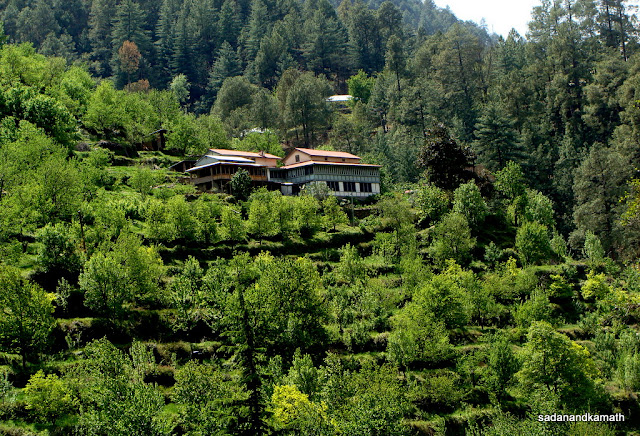 |
| Houses surrounded by mostly apple orchards near Gushaini. |
The weather turned cloudy in the afternoon and soon rains started with thunders and lightening. Tirthan River in the afternoon assuming that it would be sunny afternoon when playing in the Tirthan water would be a fun for kids. The rain stopped completely at around 4.30 pm and the sky cleared paving the way for our delayed sojourn to Trithan river. After a cup of coffee/tea, we descended on a cemented staircase to reach Tirthan river bed. After crossing few rocks and boulders, we reached the banks of Tirthan river. The water was icy cold and kids could not dare to put their feet in the water. So it was photo session on the rocks and boulders around Tirthan river. After spending an hour or so on the banks of Tirthan river, we returned to the comfort of our rooms.
 |
| In the midst of Tirthan river. |
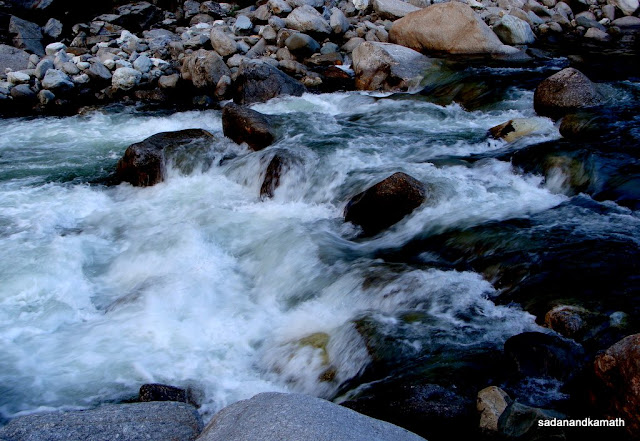 |
| Tirthan river torrent. |
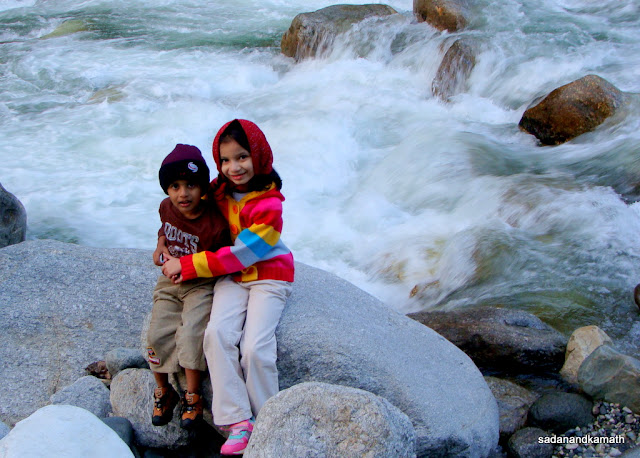 |
| Tirthan river sojourn. |
To Jalori Pass and back (30+34 kms).
When I got up in the morning around 6.00 am, the outlook for our Jalori Pass visit looked bleak with an overcast sky. Varun told me at our morning tea session that our chances of making Jalori Pass were 50:50 at that point of time. The weather continued to be cloudy when we finished our breakfast. The vehicle (Tavera @Rs.1500/- for full day) booked by Raju had already arrived on the other side of the river. The sky started getting cleared from the southern side which was a good sign. Our plan was to first visit Jalori Pass and spend some time at Shoja village on our return and take a 4 kms detour after Ghayagi for visit to Shringa Rishi temple.
After crossing Tirthan river by cable trolley, we commenced our journey to Jalori Pass around 9.15 a.m. The road passed through Banjar town where the haphazard parking of vehicles created some traffic jams resulting in slowing down the speed. After Banjar, it was all uphill road. The road up to Jibbhi was fairly in good condition but further to Ghayagi was somewhat rough ride. From Ghayagi to Jalori Pass, the road was a mix of mud and pebbles restricting the speed of our vehicle to barely 20 kmph. After Shoja, the climb to Jalori Pass was steep and just about 3 kms before the pass, snow appeared on the other side of the road which became more and more as we came close to Jalori Pass. The water flowing from the melting snow made the road slushy thus further restricting the speed to barely 10 kmph. The entire route to Jalori Pass was very scenic with road passing through the thick forest of deodar trees. We reached Jalori Pass at around 10.30 a.m.
 |
| Banjar Bus Stand |
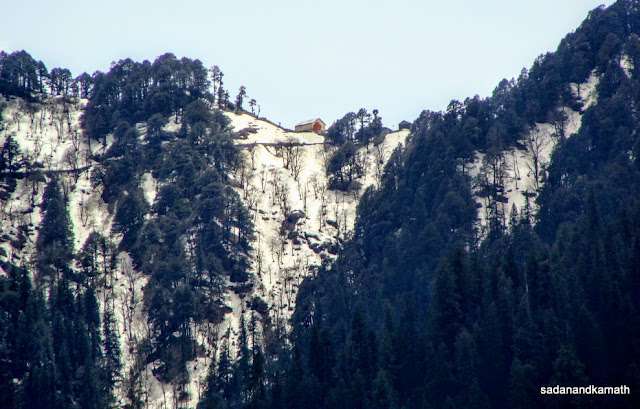 |
| Jalori Pass seen from Shoja village. |
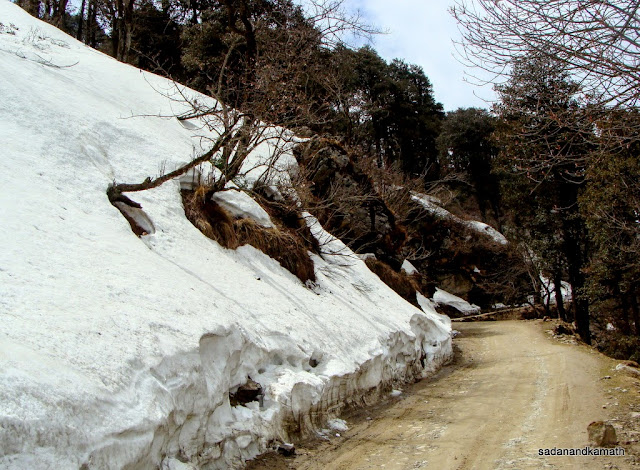 |
| Snow accumulation near Jalori Pass. |
 |
| Snow accumulation on a meadow near Jalori Pass. |
We realised on alighting from the vehicle were the chill in the air and no trace of snow on the other side of the pass (Ani side) as far as our eyes could see. Except for about 5-6 dabhas and one Kali temple, there was nothing at the Jalori Pass. We walked on the trek path to Saryalser Lake for about 1 km in the hope of getting some snow but of no avail. We return to one of the dabhas on the pass to have hot cups of tea before embarking on the snow which was accumulated left of Kali temple. Our driver took me to the top of the temple for a snow slide which I did without much problem and so did my son. Our driver then took us to a large snow covered meadow just 1 km before Jalori Pass which required a gentle climb of about 100m to be in the snow. We spent about 30 minutes on this snow carpet before proceeding to Shoja where we spent some time in a temple complex to have a good view of Jalori Pass.
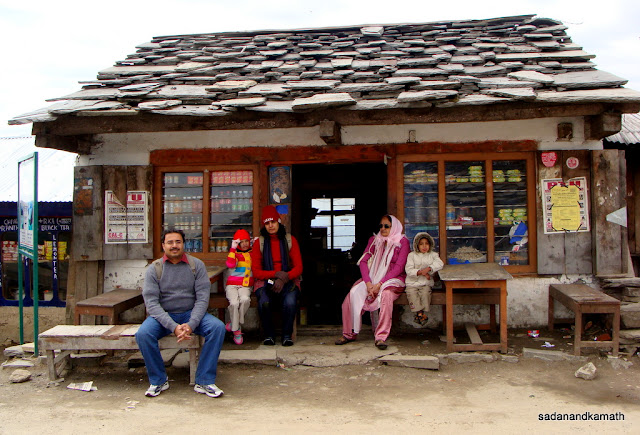 |
| One of the dabhas at Jalori Pass. |
 |
| Road towards Ani seen from Jalori Pass. |
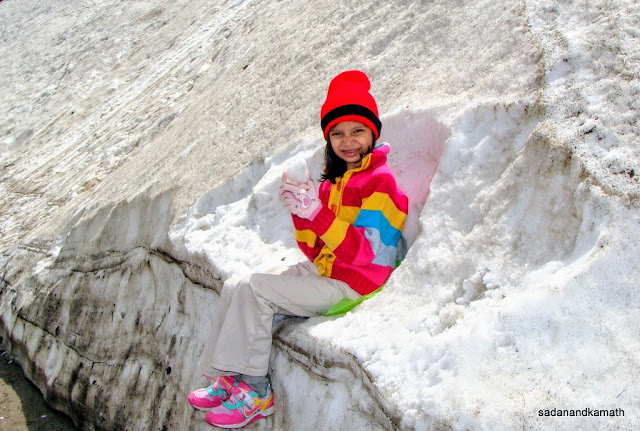 |
| On 'snow sofa' at Jalori Pass. |
 |
| My son on snow slide. |
 |
| My grandson giving a try for a snow slide. |
Since it was already 2.00 pm, we decided to skip visit to Shringa Rishi temple, a 4 km diversion on way back to Banjar and a 20 minutes' climb. But our driver took us to the road head coaxing us that it would take only 20 minutes to climb and 10 minutes to return. We agreed and visited the three storied temple. After climbing the wooden staircase inside the temple, we reached the third floor where the presiding deities were kept. One gets a good view of nearby villages and town from this temple. The priest was suggesting us to visit another temple of the same name, some 30 minutes of climb from this temple but our folks had quite exhausted by this time and decided not to go ahead. We reached the Guest House at 3.30 pm had lunch thereafter.
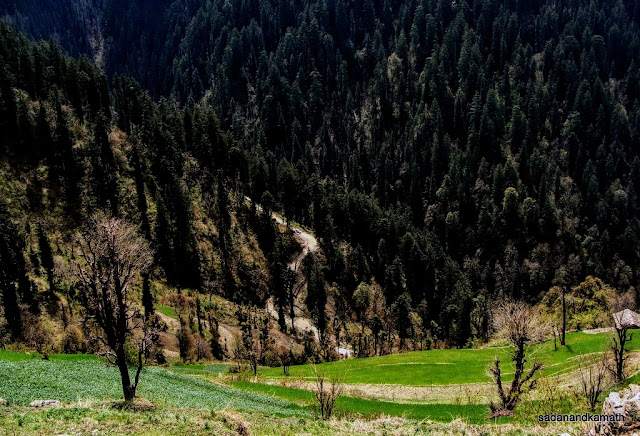 |
| View from Shoja |
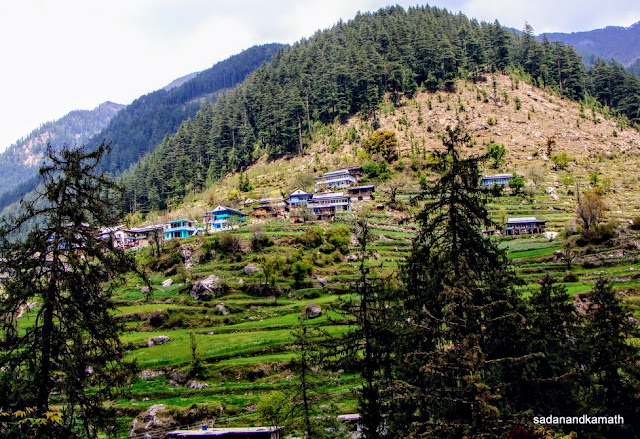 |
| Ghayagi Village |
 |
Shringa Rishi Temple
|
It rained quite heavily since mid night and rains continued in the next day morning. As we were having breakfast, heavy rains once again lashed the place. We had planned to depart at around 9.00 am for Chindi and Tavera was booked on our behalf by Raju for 2 days for Shimla drop with an overnight halt at Chindi (Rs.5000/- all inclusive) but it appeared that our departure may have to be delayed until rains stopped. The crystal green water colour in Tirthan river had turned into a muddy one and the water level had also risen by at about 2 feet as per Raju’s assessment. He was apprehensive about the fate of the make-shift mud road which passed through Tirthan river between Banjar and Larji as the road was just one foot above water level in normal times. Luckily, rains subsided and we could see Tavera waiting for us across the river.
 |
| Varun and Raju with swollen Tirthan river in the background on our departure day. |
After three days of pure bliss and pampering from Raju, his wife, Varun and five pet dogs, I was feeling sad to leave Raju's Guest House in particular and an heavenly place called Tirthan Valley in general. I made my decision to revisit the place sooner than later to explore the Tirthan Valley further. With this thought, I took leave of Raju and Varun and departed Gushaini at 09.30 am for Chindi.
More pictures :